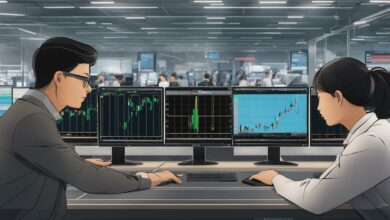The Dynamics of Implied Volatility: How Market Uncertainty Drives Spikes and What It Means for Traders

Understanding Implied Volatility and Its Relationship with Market Uncertainty
Definition of Implied Volatility (IV) and Its Significance in Options Trading
Implied volatility (IV) represents the market’s forecast of a likely movement in the price of a security. Unlike historical volatility, which looks at past price movements, IV is forward-looking and is derived from the prices of options. Options traders rely heavily on implied volatility as it influences the pricing of options contracts.
- Higher IV: Indicates that the market expects significant price changes.
- Lower IV: Suggests stability and smaller expected price movements.
For options traders, understanding IV is crucial. It can signal potential opportunities and risks, affecting decisions on buying or selling options.
How Market Uncertainty Influences Implied Volatility
Market uncertainty plays a pivotal role in driving implied volatility. When investors are uncertain about the future direction of the market, their anxiety often leads to increased demand for options as hedging instruments. This heightened demand drives up options prices, resulting in higher implied volatility.
During times of heightened anxiety among investors:
- Periods of economic downturn or financial crises tend to see sharp increases in implied volatility.
- Major geopolitical events, such as elections or wars, also trigger spikes in IV due to growing uncertainty about future market conditions.
Example: During the 2008 financial crisis, implied volatility reached unprecedented levels as fear gripped the markets. Similarly, during U.S. presidential elections, uncertainty about policy changes can lead to significant fluctuations in IV.
Understanding this relationship helps traders develop effective trading strategies to navigate volatile markets. For instance:
- Straddles and strangles: These strategies benefit from high IV environments by capitalizing on large price swings regardless of direction.
- Iron condors: Aimed at profiting from periods where high IV is expected to stabilize post-event.
When you grasp how market uncertainty drives implied volatility, you are better positioned to anticipate potential market movements and adjust your trading strategies accordingly. This understanding not only improves your risk management but also enhances your ability to capitalize on opportunities presented by volatile markets.
The Role of Market Sentiment and Speculative Activity in Driving Changes in Implied Volatility
Market sentiment acts as a mirror reflecting investor anxiety during uncertain periods. When confidence wanes, investors anticipate larger price fluctuations, causing implied volatility (IV) to rise. This heightened anxiety is often evident in bearish markets where fear and uncertainty dominate.
Speculative activity also plays a crucial role in IV fluctuations. Investors and traders look for opportunities to profit from expected market movements, leading to increased buying or selling of options contracts.

Upward Pressure on IV
- High Demand for Options: During times of increased market uncertainty, the demand for options typically surges as traders seek hedging opportunities. This increased demand drives up the prices of options, leading to higher implied volatility.
- Volatility Trading: Traders often use strategies like straddles and strangles to capitalize on anticipated volatility spikes. These strategies involve buying both call and put options, expecting significant price movements in either direction. Explore delta hedging with straddle options here.
Downward Pressure on IV
- Market Stabilization: When markets stabilize and investor confidence returns, the demand for hedging decreases, leading to lower option premiums and reduced implied volatility.
- Profit-Taking: Speculative traders may start unwinding their positions once they believe the peak of volatility has passed. Selling off these positions can lead to a decrease in demand for options, thereby reducing IV.
Speculative activity doesn’t just drive IV upward; it can also contribute to its decline. By understanding these dynamics, you can better navigate periods of high volatility and employ more effective trading strategies.
Learn about the covered call strategy which leverages low-risk approaches during periods of decreased implied volatility.
In essence, both market sentiment and speculative activity are pivotal in shaping the landscape of implied volatility. Recognizing these factors allows traders to make informed decisions and adapt their strategies accordingly.
Event-Driven Factors That Contribute to Increased Implied Volatility
Event-driven volatility is a significant driver of spikes in implied volatility (IV). During specific events, traders often anticipate increased price movements, leading to heightened IV levels. Key events that significantly impact IV include earnings announcements, economic data releases, and geopolitical events.
Earnings Announcements and Economic Data Releases
Earnings announcements are pivotal moments for individual stocks. Companies disclose their financial performance, which can exceed or fall short of market expectations. This uncertainty leads investors to adjust their positions preemptively, causing a rise in IV. For example:
- Positive earnings surprises can lead to a sharp decline in IV post-announcement as the uncertainty resolves.
- Negative earnings surprises might sustain or even increase IV if the results indicate ongoing issues.
Economic data releases also play a crucial role. Reports such as GDP growth rates, unemployment figures, and inflation statistics provide insights into the broader economic landscape. Anticipation around these releases often leads to increased options trading activity, reflecting in higher IV levels.
Geopolitical Events
Major geopolitical events can cause significant shifts in market sentiment and drive substantial changes in IV. Historical case studies highlight this relationship effectively:
- Brexit Referendum (2016): The uncertainty surrounding the UK’s decision to leave the EU led to elevated IV levels across various markets.
- U.S.-China Trade War: Ongoing trade negotiations and tariff announcements resulted in fluctuating IV as market participants reacted to new developments.
- U.S. Presidential Elections: Every election cycle introduces uncertainty regarding future policies, impacting everything from regulatory environments to international relations.
These geopolitical factors often lead to spikes in IV as traders seek protection against potential adverse movements by purchasing options contracts.
The interplay between event-driven factors and option pricing dynamics brings a critical layer of complexity to trading strategies. Understanding these catalysts allows traders to navigate the markets more effectively during periods of heightened uncertainty.
By recognizing the types of events that drive increased implied volatility, traders can better anticipate market movements and make informed decisions about their positions. This understanding is crucial for managing risk and capitalizing on opportunities presented by volatile market conditions.
Understanding Supply and Demand in Options Trading and Its Impact on Implied Volatility
The dynamics of supply and demand play a crucial role in determining the levels of implied volatility (IV) within the options market. This is especially true during times of market uncertainty when these forces can cause significant fluctuations in IV.
How Supply and Demand Affect Implied Volatility
Increased Demand
When investors expect higher market volatility, they often try to protect their positions by buying more options contracts. This increased demand pushes up the prices of these options, which in turn raises IV. For example, during economic downturns or geopolitical tensions, the rush to buy protective puts can lead to noticeable spikes in implied volatility.
Limited Supply
On the other hand, if there aren’t many options available for trading, this scarcity can further increase IV levels. Market makers may ask for higher premiums to compensate for taking on more risk during uncertain times.
The Role of Hedging Strategies
Hedging strategies also play a significant role in influencing demand and subsequently impacting IV. Traders and institutional investors use various strategies to reduce risk, resulting in increased activity in the options market.
Straddles and Strangles
These neutral options strategies involve buying both call and put options with the expectation that significant price movements will occur, although the direction is uncertain. As traders implement more of these strategies, it drives up demand for both calls and puts, thereby increasing IV.
For those interested in learning more about neutral strategies, this resource provides valuable insights.
Call Ratio Spreads
Another strategy affecting IV is the call ratio spread. This involves buying a certain number of call options while selling a greater number at a higher strike price. The execution of such spreads can influence the demand dynamics for calls at different strike prices, ultimately impacting overall IV levels.
To delve deeper into this strategy, check out this detailed guide.
During uncertain market conditions, hedging becomes a priority for many traders. As they employ complex strategies to safeguard their portfolios, their actions can create upward pressure on IV.
Why Understanding Supply and Demand Dynamics Matters
Knowing how supply and demand dynamics affect implied volatility is essential for any trader navigating volatile markets. By recognizing these patterns, you can better predict changes in IV and adjust your trading strategies accordingly.
For an in-depth explanation of implied volatility concepts, refer to this comprehensive article.
Political Events: A Unique Catalyst for Spikes in Implied Volatility
Political events often serve as significant catalysts for spikes in implied volatility (IV). Historical data shows a clear correlation between major political events, such as U.S. presidential elections, and heightened IV levels.

Historical Context
During politically charged periods, market participants experience increased uncertainty regarding future economic and policy directions. This uncertainty is typically reflected in the options market through elevated IV. For instance:
- U.S. Presidential Elections: These events are prime examples of how political uncertainty can drive up IV. The 2020 U.S. election saw significant spikes in the VIX index, commonly known as the “fear gauge,” as investors grappled with potential shifts in economic policies and international relations.
- Brexit Referendum: Another notable instance is the Brexit referendum in 2016, which led to a dramatic increase in IV due to concerns over its economic implications for the UK and EU.
These historical events underline how political developments can lead to rapid changes in market sentiment, driving traders to seek protection through options contracts, thereby increasing demand and IV.
Risk Management Considerations
Navigating periods of high implied volatility driven by political events requires robust risk management strategies. Traders should be aware of several key considerations:
- Diversification: Spreading investments across various asset classes can mitigate risk.
- Hedging Strategies: Employing hedging techniques such as using options or futures contracts can protect against adverse price movements.
- Stay Informed: Regularly updating oneself on political developments helps in anticipating market reactions.
- Volatility Indicators: Monitoring indicators like the VIX can provide valuable insights into market sentiment.
By understanding the dynamics at play during political events, traders can better manage risks and capitalize on opportunities presented by spikes in implied volatility.
Trading Strategies to Navigate High Implied Volatility Environments Effectively
Elevated implied volatility (IV) environments present unique opportunities and challenges for traders. To navigate these periods effectively, several high IV trading strategies can be employed:
Straddles and Strangles
- Straddles: This strategy involves buying both a call and a put option at the same strike price and expiration date. It benefits from significant price movements in either direction.
- Strangles: Similar to straddles but with different strike prices for the call and put options. This approach is typically cheaper but requires an even larger movement to be profitable.
Iron Condors
An iron condor involves selling an out-of-the-money put and call, while also buying further out-of-the-money options to limit potential losses. This strategy profits from low volatility when the underlying asset stays within a specific range.
Calendar Spreads
Calendar spreads, or time spreads, involve buying and selling options of the same type (calls or puts) with the same strike price but different expiration dates. This strategy aims to capitalize on time decay differences between short-term and long-term options.
These strategies can be particularly effective during high IV periods.
Understanding systematic versus unsystematic risk can also enhance your trading decisions during volatile times.
Additionally, protecting your portfolio using index puts is a viable tactic in volatile markets.
Leveraging these strategies allows traders to turn volatility into profit while managing risks effectively.







